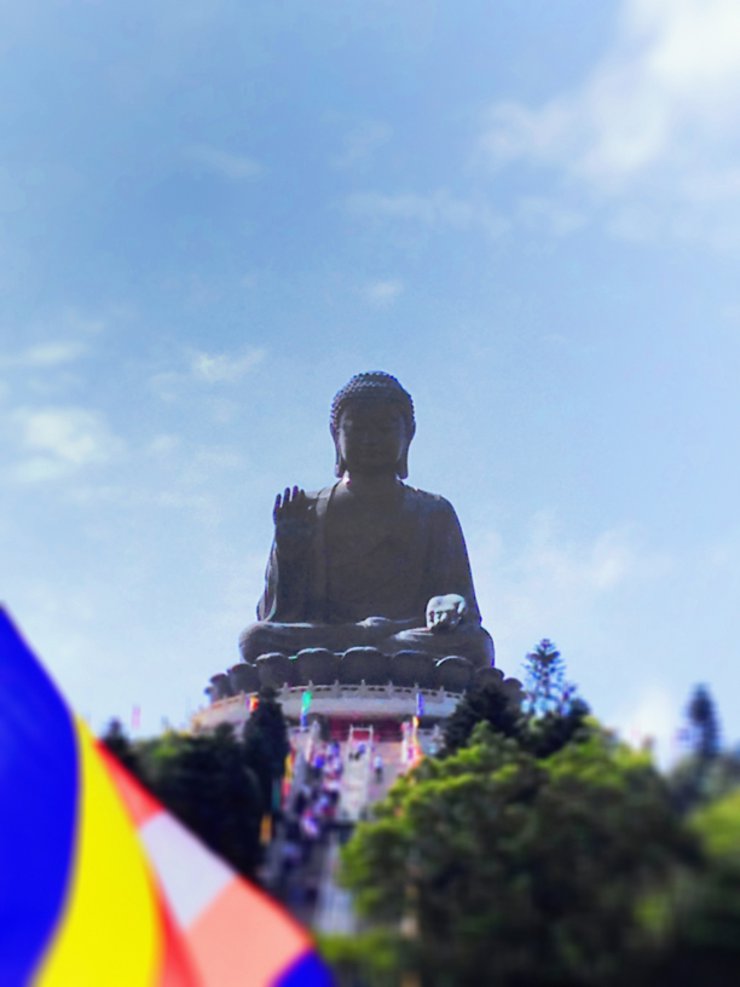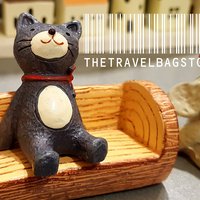Hong Kong Pilgrimage: A Journey of Faith and Photography
This year, I embarked on a pilgrimage to Hong Kong, seeking respite from the scorching heat and immersing myself in the city's spiritual essence. While I typically document my travels with a professional camera, this year's focus was on visiting nine sacred temples. Therefore, I relied on my iPhone, acknowledging that the resulting images, though enhanced through editing, might not meet the standards of professional photography.
My accommodation was at the Y-Loft Hotel, conveniently located at the end of the MTR Island Line. The journey to the city center took approximately 25 minutes, similar to traveling from Bearing to Silom in Bangkok. The hotel impressed with its cleanliness and affordability, costing less than 3,000 baht per night during the New Year period. While the water pressure was excellent, the Wi-Fi, despite its speed, suffered from frequent disconnections.
Now, let us shift our focus from the hotel review to the spiritual journey that unfolded.
Our first stop is the **Giant Buddha at Po Lin Monastery on Lantau Island**. This year, we took the bus up, and the view was just as beautiful. Make sure to sit on the driver's side for the best views.

The point of worship for the large Buddha statue is not at the top of the stairs, as this is a test of faith. The true point of receiving blessings is on the stage. Stand on the circular mark, similar to the Temple of Heaven in Beijing. When praying to the Buddha, you must look at his face, and do not close your eyes and pray in the Thai style.

May the blessings of the Lord Amitabha bring happiness and prosperity to all members of Pantip.

Those who have strong legs can walk to the base of the Buddha statue at the top (I thought I wouldn't climb this year, but I decided to test my fitness a bit).

The reward for climbing is a breathtaking view like this. The weather in Hong Kong was fantastic before the new year.

The Big Buddha, also known as Tian Tan Buddha, sits atop a lotus-shaped altar inspired by the Temple of Heaven in Beijing (a site for imperial worship since the Ming Dynasty). Standing at 34 meters tall and weighing 250 tons, the Buddha's grandeur is said to be visible from Macau on clear days. Construction began in 1990 and was completed on Vesak Day in 1993.

Getting to Po Lin Monastery and the Big Buddha is easy, as it is located at the end of the Tung Chung line. The starting point is at Hong Kong Station, which connects to Central Station (walking can be tiring, so I recommend walking above ground, where there is a Sky Walk that passes through various shopping malls. If you are not in a hurry). It takes about half an hour to reach Tung Chung. Once you arrive, you can choose to take the Ngong Ping cable car or the bus. Both are located next to Citigate Mall. Take bus number 23. The bus departs every 30 minutes. It is a good idea to check the departure times. If you don't want to stand, arrive early. I went on a weekday, and it was still crowded, but I didn't have to stand the whole time. On the way back, I had to stand for a while. If you have the chance, take another bus from Ngong Ping to Tai O to see the local atmosphere of Hong Kong. This town is also a historical town. It is said to be the place where the last emperor of the Song Dynasty, Emperor Bing of Song (Zhao Bing), jumped into the water to escape the Mongols.


We are back and heading to the second temple, **Wang Da Xian Temple**.

The Wong Tai Sin Temple: A Taoist Sanctuary in Hong Kong
The Wong Tai Sin Temple, also known as Huang Tai Sin Temple, is not a Buddhist temple but a Taoist one. It is among the most revered temples in Hong Kong and among overseas Chinese communities.
The temple was founded by Liang Renan, a qigong and herbal medicine practitioner from Guangdong who immigrated to Hong Kong in 1915. He initially set up a clinic in Wan Chai, where he also established an altar dedicated to Wong Tai Sin, a deity associated with healing. Following a fire that destroyed his clinic, Liang Renan had a vision in which Wong Tai Sin instructed him to build a new place of worship. He followed the deity's guidance, walking from Kowloon Pier for 3,900 steps to the village of Chuk Yuen, where he established the temple.
In its early years, the temple served primarily as a place of practice for Taoist devotees. It wasn't until 1956 that it was opened to the public for general worship.

Wong Tai Sin Temple, as mentioned, is also a temple dedicated to the deity of medicine. Most people tend to worship here, especially during the New Year and on the 23rd day of the 8th lunar month, which is believed to be the deity's birthday. It is believed that praying here will bring good health and longevity. Notably, during Chinese New Year, everyone waits until midnight when the new day begins, which is the real new year, to celebrate by inhaling the incense smoke (similar to the Japanese). This is done to symbolically absorb good fortune and blessings.

As this temple is a popular destination for Thai people, and iPhone cameras do not capture its beauty adequately, I did not take any photos of the surrounding area. However, I can assure you that it is truly magnificent.

The journey to Wong Tai Sin Temple is effortless, with the MTR station conveniently located right in front. Take the Kwun Tong Line (KTL) and alight at the eponymous Wang Tai Sin Station. This is especially convenient for those staying in Yau Ma Tei or Mong Kok. Our second temple visit concludes here. Let's proceed to the third temple, Chi Lin Nunnery, which is adjacent to Wong Tai Sin Temple. Travel one more station and disembark at Diamond Hill Station. Notably, both stations are connected to shopping malls. While these malls are slightly outside the city center, they are still quite large, particularly the one at Diamond Hill Station, which boasts a massive Marks & Spencer store. The quality of the stores here is arguably better than those near Wong Tai Sin Temple.

In stark contrast to the bustling atmosphere of Wong Tai Sin Temple, Chi Lin Nunnery offers a serene and tranquil environment. The temple embodies the essence of pure Buddhism, reflecting the Chan or Zen tradition that flourished in China during the Tang dynasty and served as a model for Japanese Buddhism. While the architecture resembles Japanese temples, it is more accurate to say that Chi Lin Nunnery served as the prototype for Japanese temple design. The emphasis here is on tranquility, with no incense burning and a focus on chanting. As a result, the temple does not typically accommodate tour groups. I am unsure if tours have ever been conducted, but if they were, it would be necessary to remind visitors, particularly Thai tourists, to be mindful of their volume. Thai people tend to be loud, contrary to popular belief. During my visit to the nunnery, I found myself completely immersed in the peaceful atmosphere, losing track of time for several hours. The cool air further enhanced the experience, making Chi Lin Nunnery my personal favorite temple in Hong Kong.

Built in 1934 and renovated in 1990, Wat Cheelin is a temple with Tang Dynasty architecture, as mentioned earlier. Its distinctive feature is its all-teak structure, where the wood pieces are interlocked to achieve structural stability without the use of nails. This construction method is commonly seen in Chinese, Korean, and Japanese temples. In contrast, Chinese temples in Thailand often incorporate Taoist elements, similar to Wat Wang Da Xian or Wat Borom Raja Varavihara. The temple houses statues of Gautama Buddha, the current Buddha, Maitreya Buddha, the future Buddha, Guanyin, and various other bodhisattvas. The most stunning statue is the golden Thousand-Armed Guanyin, which closely resembles those found in Narita or Kyoto temples. Photography is prohibited inside the temple.

Another point of interest in the temple is the Nan Lian Garden, which is decorated in the Zen or Tang style. It is currently open as a public park and houses a museum with miniature replicas of various temples throughout China, Hong Kong, and Taiwan, all constructed from wood in the same style.

I will be ending my tour at the third temple tonight. Tomorrow, I will visit another temple in a different part of the city, which is located near Ngong Ping. If you don't have enough time, you can plan your trip accordingly. Good night.

The next stop is Wat Yuan Yuan, also known as the Yuan Yuan Institute or Wat Ki Phao. Wat Yuan Yuan may have been less known to Thais in the past, but after the movie "Ki Phao" was filmed there, it has become a popular tourist destination. Located in the Chun Wan district at the foot of Mount Sam Dip Tam (probably), Wat Yuan Yuan is notable for its collection of the three sacred objects of China: Buddhism, Taoism, and Yu (Confucius).

At Yuan Yuan Temple, most people come to worship the deity Tai Sui, especially during the New Year to pray for protection from misfortune, particularly those born in the clashing year. The central part of the temple features a Hall of Heaven modeled after the Temple of Heaven in Beijing, with a replica of Tai Sui inside. Moreover, the temple is renowned for its auspicious feng shui, believed to bring good fortune to those who pay their respects.

I'm not sure if there was a festival to see the Benjamas flowers or other flowers on the day I went, but there were a lot of people. However, I arrived at the end of the event, but I was still able to enjoy the beauty.

The event also featured a bonsai contest, which attracted a large number of Chinese tourists.

The beauty of Wat Yuan Yuan is undeniable. Adjacent to the temple is a Western Monastery with an octagonal pagoda. We continued our exploration, as they were situated close to each other.

Western Monastery can be considered a park dedicated to the Bodhisattva Guanyin, as it houses numerous statues of the deity.

The Guan Yin of Many Forms Park is located at the front. Inside, there is a very large and beautiful statue of Guan Yin, which I forgot to take a picture of to worship.

Let's move on to the other side and take a look inside.

Built in 1962, the Western Monastery stands in stark contrast to the rural landscape of Lo Wai village. The Northern Territories, where the village is located, offer a glimpse into a world far removed from the bustling metropolis of Hong Kong, akin to the rural outskirts of Bangkok or Hanoi. The monastery's nine-story pagoda houses statues of the five Tathagatas, alongside depictions of the Buddha's life in a distinctly Chinese style.

The interior houses a nine-story stupa.

The Western Monastery appears to be less crowded and more peaceful than the Yuan Yuan Temple. I consider both of them as one place for the 9 Temples Pilgrimage project, because if I count them separately, including the Western Monastery, it would be too spread out.

The journey is neither difficult nor easy, as the MTR does not reach the destination directly. The nearest stations are Tsuen Wan and Tsuen Wan West. Tsuen Wan is recommended due to its easier access. If you plan to visit the Big Buddha at Ngong Ping, you can transfer at Lai King station. Upon arrival at the station, there is a large shopping mall connected to it. Walk straight and look to your right for the Bus Terminal and Taxi Terminal. I took a taxi, which was convenient. Choose only red taxis and tell the driver "Ngong Ping Cable Car Terminal." The fare on a Sunday was around 80 HKD, which was convenient. If you prefer to take the bus, you can, but I didn't because there was a long queue. This year, I opted for a taxi instead. To travel by bus, exit from MTR Exit B1 and connect to the shopping mall. You will see Sai Lau Kok Park. Cross the footbridge, turn right, and then turn right again to find the bus stop for minibus route 81 on Siu Wo Road. That's the bus you need to take.

The fifth temple, Wat Tin Hau, also known as Tian Hou or the Goddess of Heaven.

There are many Tin Hau temples in Hong Kong, but the one I'm taking you to is located in the heart of the city, with an MTR station of the same name. It's on Hong Kong Island. The other two Tin Hau temples are located in Yau Ma Tei and Stanley Market. The oldest and largest temple is located on the Kowloon side, in Joss House Bay. This temple also boasts a long and rich history.

The Tin Hau Temple: A Sanctuary for Seafarers and the Chinese Diaspora
The Tin Hau Temple stands as a testament to the resilience and faith of the Hakka people, who migrated from Guangdong and settled in Kowloon in the 18th century, before Hong Kong became a British colony. While gathering herbs on Hong Kong Island, they discovered a statue of the goddess Tin Hau, revered as the protector of seafarers. This led them to establish a temple in her honor.
Tin Hau, also known by various names such as Mazu, Tianfei, and the Queen of Heaven, is a deity deeply revered by overseas Chinese communities and coastal populations from Fujian (Hokkien) to Hainan (Hainan), Vietnam, Thailand, Malaysia, and Singapore. Legend has it that she was born in Fujian during the reign of Emperor Taizu of Song. However, it was Kublai Khan who officially bestowed upon her the title of "Empress of Heaven," a privilege reserved for emperors as sons of heaven. Another legend places her birth on Hainan Island, dating back to the Han Dynasty, over a thousand years before the first legend.
The Tin Hau Temple serves as a spiritual haven for seafarers and the Chinese diaspora, embodying their cultural heritage and unwavering faith in the goddess who protects them on their journeys across the vast expanse of the sea.

The journey is very convenient. Simply alight at Tin Hua Station on the Island Line, and follow the clear signage provided.

Immerse yourself in the Christmas atmosphere with these two deities.

This is the sixth temple I've visited. I'm going to pay respects to the deities at Repulse Bay, another well-known spot among Thai people. Repulse Bay is a hub for deities, including the Longevity Bridge, Cupid, Lord Cai Shen, the Three Suns Ram, the Dragon God, the Goddess of the Sea, Lord Di Kui Li, and even Brahma. Visitors to this location pray to all of the deities, seeking wealth, children, and good health.

Repulse Bay is a crescent-shaped beach renowned for its beauty and is considered the most stunning in Hong Kong. Situated on the southern coast of Hong Kong Island, it is conveniently located near Ocean Park and Stanley Market. Historically, the bay was a haven for pirates who preyed on foreign and Chinese merchant ships. However, their reign was brought to an end when the British conquered Hong Kong and established it as a colony.

The former Replus Hotel, which had to drill a hole in the middle to allow the dragon to pass through and play in the water, managed to avoid bankruptcy.

Repulse Bay Transportation
There is no MTR station directly at Repulse Bay. However, there are plans to extend the line to Ocean Park, which is not far away. Even then, the walk from the station to Repulse Bay would be quite strenuous due to the hilly terrain.
Instead, it is recommended to take the MTR to Central Station and exit through the Exchange Square exit. This exit connects directly to the IFC building. From there, you can find the bus terminus and take bus routes 6, 6A, 6X, or 260 to reach Repulse Bay.
The seventh temple, Wat Kaew Ko, also known as Wat Chak Kham Wiao.

Che Kung Temple, located in Sha Tin, Kowloon, is one of the oldest temples in Hong Kong, dating back over 300 years. It is dedicated to Che Kung, a legendary military figure known for his victories in battle. According to legend, Che Kung always spun a pair of windmills before going into battle, ensuring his success. The image shown is not of Che Kung himself, but rather his loyal followers. Due to his immense stature, Che Kung's image is prohibited from being photographed.

The Chak Wang Temple is also popular for the Jik Ji Pei Diamond Windmill ceremony. Most people who buy the windmill will come here to perform the ceremony of rotating the windmill. However, the shop has already performed the ceremony.

This includes the opportunity to resolve one's zodiac year clash. There is no need to worry about language barriers at this temple, as Thai is spoken fluently. Additionally, various ceremonies are explained in Thai, and it seems that there may even be more Thai visitors than Hong Kong locals. It is uncommon to see Hong Kong residents performing rituals to resolve their zodiac year clash.

The journey is not difficult, but do not get off at the station with the same name as the temple, Che Kung Temple Station, as it is a long walk and you will need to transfer to another bus. The nearest station is Tai Wai Station, which is a major interchange for trains and buses. Walk out of Tai Wai Station to the bus stop and you will see the temple roof. There is also a park near the temple, which is very peaceful. The atmosphere is very suburban. Oh, Tai Wai Station is a train that goes directly to Shenzhen.

Another temple will take us across the border to Macau, but first, let's take a stroll and browse the toys in Mong Kok to lighten the mood.

This is Temple Street, a popular spot in Hong Kong, similar to Chatuchak in Thailand. However, the weather here is much cooler and more comfortable. Let's cross the sea to Macau to visit a temple. The first temple is Kun Iam Temple.

The Kun Iam Temple, also known as the A-Ma Temple, is the oldest and largest temple in Macau. It has a history of over 600 years and is a significant historical site, having hosted the signing of the Sino-American Treaty of Peace in 1844.

The temple houses numerous statues of deities and bodhisattvas from the Mahayana tradition. At the entrance, the Four Heavenly Kings stand guard, while the main hall features three principal Buddha statues: the central figure of Gautama Buddha flanked by Maitreya Buddha and Manjushri Bodhisattva. The next hall houses the statue of Maitreya, the future Buddha, and the innermost sanctum enshrines the bodhisattva Guanyin. When paying respects, it is customary to begin with Guanyin, who is known as Nanshan Dafo Pusa, meaning "Great Dharma Master of the Southern Sea" (reminiscent of the character in the novel "Demi-Gods and Semi-Devils"). Guanyin is often mistakenly depicted in bridal attire, but her actual attire is that of a Dharma Master.

The photographs of the various Buddha statues are not as numerous as those found on Pantip, as there are already many images available there. Reaching the temple is not difficult, even though Macau lacks a metro system (although it would be logical given its smaller size compared to Hong Kong). Taking the bus is a convenient option, with routes 6, 12, 17, 18, 19, 22, 23, and 28C passing by. Taxis are also readily available from the port, with fares typically not exceeding 80 Baht.

Next to the Guanyin Temple, there is another small temple. The interior is just as beautiful, but not as many people visit it. Here are pictures of the Goddess of Heaven surrounded by the Eight Immortals, Tang Sanzang, Nezha, and Sun Wukong.

The final temple, A-Ma Temple, or the Temple of the Goddess of the Sea, is the origin of the name Macau, which was a Portuguese mispronunciation.

The A-Ma Temple in Macau, similar to its counterpart in Hong Kong, is dedicated to the goddess of the sea, Mazu. Situated on Mount Barra, the temple was built to honor Mazu and commemorate her legendary visit to the island. According to local lore, Mazu, originally a young woman named Lin Mo from Fujian, miraculously survived a storm while crossing to the Aomen Peninsula (Macau in Mandarin). Her boat landed safely at the site of the present-day temple, after which she ascended to heaven. This event led to the area being named A-Ma Gau, meaning "Bay of A-Ma," which the Portuguese later adapted as "Macau."

The bus routes that pass by A-Ma Temple are routes 5 and 10. These routes also pass by Senado Square.

The journey to worship at 9 temples has been completed as planned. I will share pictures of the Western temple later. Thank you to all of you who have visited. (Speaking to myself sadly and then leaving. Thank you all.)




www.facebook.com/thetravelbagstory
TravelTherapy
Wednesday, October 9, 2024 5:58 PM
















